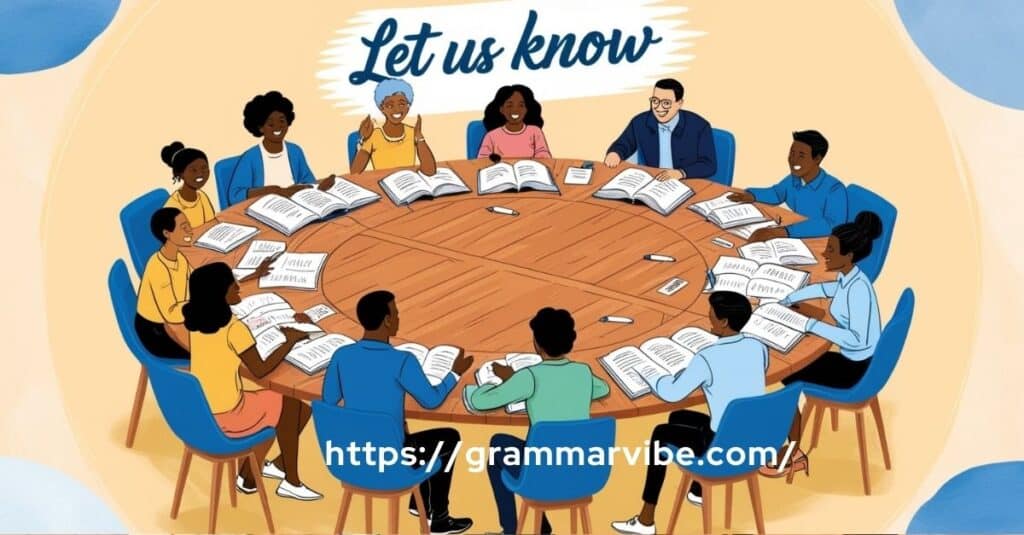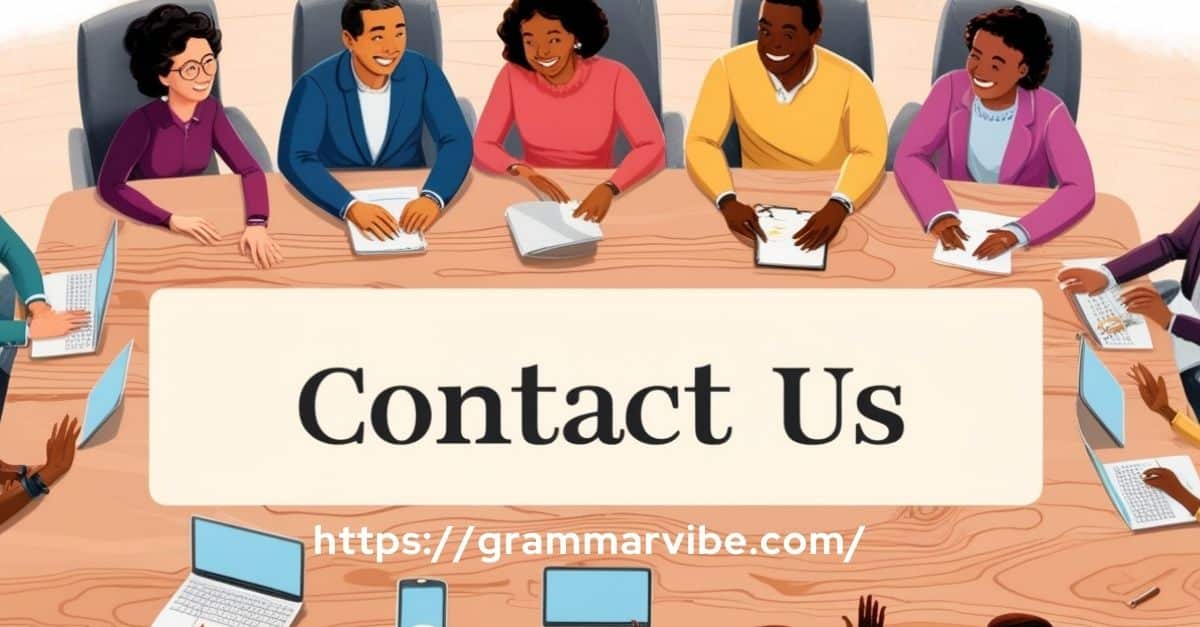When browsing through various websites or customer service portals, you’ve probably seen the phrase “Contact us” hundreds of times. While it’s a simple and clear call to action, it can also feel a bit tired and overused. If you want to bring some fresh energy to your communications or make them feel more personal and approachable, it’s time to explore other ways to invite people to reach out. This article will cover 15 alternative expressions for “contact us”, offering a variety of tones, from formal to friendly, and showcasing how each can be used in different scenarios like emails, social media, or customer support.
Whether you’re looking to invite people to communicate casually or establish more professional communication, there’s an expression to fit every context. Let’s dive into these alternatives, explore their uses, and see how they can enhance your customer engagement!
1. Get in Touch
“Get in touch” is one of the most versatile alternatives to “contact us.” It’s friendly yet professional, making it perfect for business websites or social media. It invites users to initiate communication without being too formal.
Scenario Example:
Email:
“Hi Sarah,
If you have any questions about our services, please get in touch. We’d be happy to help you!”
— Customer Support Team
Why Use It?
This phrase works well in emails, support pages, or general inquiries because it offers a welcoming tone that doesn’t sound too abrupt or impersonal.
2. Reach Out
To reach out is another great alternative. It feels warm and supportive, making it ideal for customer service or situations where you want to emphasize the act of reaching out for help or guidance.
Scenario Example:
Customer Service Page:
“Need assistance with your order? Don’t hesitate to reach out to our support team for help.”
Why Use It?
This phrase implies that you’re ready to extend help or support, so it’s perfect for a help desk or any customer-facing interaction where service is central.
3. Talk to Us
“Talk to us” is a direct, friendly invitation to start a conversation. It’s great for companies that want to foster a casual conversation with their users or customers.
Scenario Example:
Live Chat Button on Website:
“Have a question? Talk to us now for an immediate response!”
Why Use It?
It’s a personalized assistance invitation that feels conversational and approachable, ideal for situations where live chat is available or you want to invite dialogue.
4. Connect with Us
If you’re looking to encourage ongoing relationships, “connect with us” is an excellent option. It implies building a connection, whether for business or social purposes, making it perfect for social media or any engagement-driven website contact.
Scenario Example:
Social Media Profile:
“Stay updated with our latest posts and news. Connect with us on Facebook and Twitter.”
Why Use It?
This expression is great for business inquiries or feedback on social platforms, where the goal is to create lasting engagement.
5. We’re Here for You

“We’re here for you” is an empathetic and reassuring phrase. It suggests that your team is available whenever customers need assistance, which is great for support-focused situations.
Scenario Example:
Customer Service Page:
“During these challenging times, remember that we’re here for you. If you need any help, feel free to reach our support team.”
Why Use It?
Perfect for customer inquiries or sensitive situations, this phrase conveys warmth and assurance that assistance is just a message or call away.
You might also like: 15 Other Ways to Say “How Was Your Day?”
6. Drop Us a Line
This phrase is informal and friendly, inviting customers to reach out in a light, relaxed way. It’s best used in emails or informal communication channels.
Scenario Example:
Email:
“Interested in our latest product? Drop us a line, and we’ll get back to you with all the details.”
Why Use It?
It’s ideal for situations where you want to keep things light-hearted or informal, without the pressure of a formal communication exchange.
7. Send Us a Message
“Send us a message” is clear and concise. This is perfect when you want to simplify the act of contacting you, especially on websites or social platforms where messaging is a common form of communication.
Scenario Example:
Website Contact Form:
“For any business inquiries, please send us a message, and someone from our team will respond promptly.”
Why Use It?
This phrase makes the process seem easy and accessible, offering a simple call to action for customer support or feedback submissions.
More for you: 15 Other Ways to Say “I Hope Everything Is Going Well”
8. Let’s Chat
If you want to sound extra approachable, “Let’s chat” invites people to have a more informal, engaging conversation. This phrase is perfect for customer support teams that want to create a friendly environment.
Scenario Example:
Live Chat Feature:
“Need some advice? Let’s chat—we’re here to help!”
Why Use It?
It works well for instant support via live chat, where real-time, friendly conversations can help resolve queries quickly.
9. Speak to Our Team
For a more formal tone, “speak to our team” is ideal. It suggests that multiple people are available to assist and implies a professional level of service.
Scenario Example:
Professional Email:
“To discuss your business inquiries, please speak to our team at your earliest convenience.”
Why Use It?
This phrase is especially helpful in professional communication contexts, such as business inquiries or technical support where expertise is expected.
10. Reach Our Support
“Reach our support” suggests a more formal and structured approach to contacting the right department. It’s great for times when specific support is required, like troubleshooting or technical help.
Scenario Example:
Support Desk:
“If you’re experiencing issues with your account, please reach our support for assistance.”
Why Use It?
It’s perfect when a help desk is involved, ensuring that customers know exactly where to direct their concerns for query resolution.
Check out this: 15 Other Ways to Say “Stay Tuned”
11. Message Us
“Message us” is short and sweet. It works well on social media platforms or when encouraging visitors to send inquiries through a contact form or direct messaging system.
Scenario Example:
Social Media Direct Message:
“Got a question? Message us directly for a fast response!”
Why Use It?
This is a quick and easy invitation to send a message, particularly on social media or apps where messaging is the primary form of communication.
12. Ask Us Anything
This phrase invites open-ended questions and encourages customers to feel comfortable seeking answers. It’s best used in informal or friendly settings, such as live chats or Q&A sections.
Scenario Example:
FAQ Page:
“Have a burning question? Ask us anything, and we’ll do our best to assist you.”
Why Use It?
This works well for FAQs or community-driven content where people can ask specific questions or get help.
13. Let Us Know

“Let us know” is a casual, direct invitation to provide feedback or ask questions. It’s great for any type of customer service situation where you want people to feel encouraged to reach out for help.
Scenario Example:
Website Footer:
“Have suggestions? Let us know how we can improve your experience!”
Why Use It?
This phrase feels open and non-pressuring, perfect for feedback and non-urgent communication.
14. Contact Our Team
“Contact our team” is a more formal version of “contact us.” It’s particularly useful when directing people to a department or specific group of experts.
Scenario Example:
Professional Business Email:
“For any business inquiries, please contact our team at [email]. We’ll respond as soon as possible.”
Why Use It?
This is a great option for situations requiring a team to handle specific tasks or requests, ensuring clear direction for the recipient.
For your interest: 15 Other Ways to Say “For the First Time”
15. Ping Us
“Ping us” is a very informal and tech-savvy phrase. It’s great for industries where customers are familiar with quick, digital communication, such as tech companies or startups.
Scenario Example:
Tech Support Email:
“Having trouble with the app? Ping us, and we’ll help you sort it out!”
Why Use It?
This phrase is modern, fast, and casual, making it perfect for instant support or informal communication.
Summary Table of Alternatives to “Contact Us”
Here’s a table summarizing all the synonyms for “Contact Us” mentioned in the article:
| Alternative Phrase | Description/Context |
|---|---|
| Get in touch | Friendly, general communication (emails, websites) |
| Reach out | Support or assistance-focused, inviting help |
| Talk to us | Direct, conversational approach for customer interaction |
| Connect with us | Building relationships, often used for social media |
| We’re here for you | Reassuring, empathetic, emphasizing availability |
| Drop us a line | Informal, light communication, often for inquiries |
| Send us a message | Clear, direct invitation for messaging (websites, forms) |
| Let’s chat | Casual, friendly conversation, often used for live chat |
| Speak to our team | Professional, formal communication with a group of experts |
| Reach our support | Directed communication to the support desk or team |
| Message us | Simple, straightforward invitation to send a message |
| Ask us anything | Open-ended, welcoming questions, used in FAQs or Q&A |
| Let us know | Casual, inviting feedback or suggestions |
| Contact our team | Formal, directing inquiries to a specific department |
| Ping us | Informal, tech-savvy, quick communication |
Conclusion
Using varied phrases like “Get in touch” or “Talk to us” instead of the typical “contact us” helps make your communication more engaging and personal. Each phrase fits a different context, whether it’s for customer service, business inquiries, or social media. By selecting the right expression, you can improve customer engagement and encourage easier, more natural communication.
These alternatives not only add freshness to your website or emails but also make it easier for customers to reach out. Choose the right call to action to enhance your customer support and connect better.

Kyren Paul is an experienced blogger and the creative mind behind “Grammar Vibe.” With a passion for the nuances of English grammar, he brings clarity and insight to everyday language topics, making grammar accessible and engaging for readers of all levels.











Leave a Comment